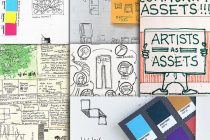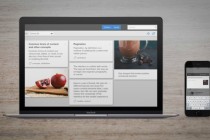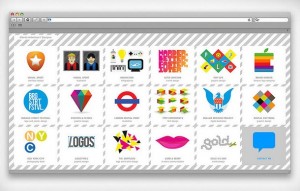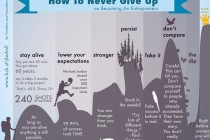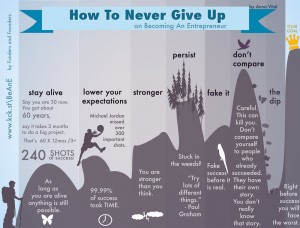16 Famous Designers Show Us Their Favorite Notebooks
Designers from Ikea, Pentagram, Ideo, and more tell us what makes a great notebook.
Sure, digital design apps might be finally coming into their own, but there’s still nothing better than pen and paper.
It turns out they didn’t. Across multiple disciplines, almost every designer we asked was thrilled to tell us about their notebook of choice and give us a look at how they use it. Our operating assumption going in was that most designers would probably be pretty picky about their notebooks, but this turned out not to be true: While Muji and Moleskine notebooks were the common favorites, some even preferred loose paper.
But what makes the notebooks of designers special isn’t so much what notebook they use, as how they use them. Below, enjoy a peek inside the working notebooks of some of the most prolific designers today—as well as their thoughts on what makes a great one.
GADI AMIT: PRESIDENT AND PRINCIPAL DESIGNER, NEWDEALDESIGN
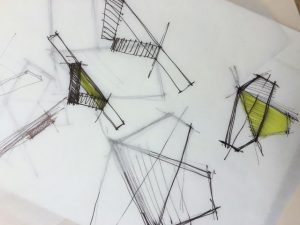
“[My favorite notebook] is plain, simple tracing paper, (Bienfang’s Parchment 100), and a medium-width felt-tip pen, such as Flair’s PaperMate. Yet I am not picky. Anything goes, ballpoint, pencil, and more.
“It’s just a quick (and dirty!) way of getting to the core of ideas quickly and moving forward.”
MICHAEL BIERUT: PARTNER, PENTAGRAM
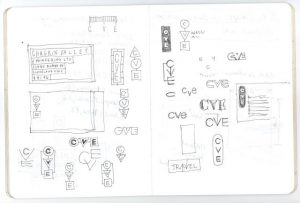
“Since 1982, I’ve been using slightly different versions of the same 7-1/2 by 9-3/4-inch school composition book. I save all of them and am now on number 110. I never go anywhere without my notebook. They are so important to me that the first chapter in my new book is dedicated to them, and I reproduce nine spreads from them at actual size. At my recent retrospective at the School of Visual Arts Gallery, an entire room was dedicated to them.
“I like them because they are inexpensive, easy to find, and anything but precious. I could never use a leather-bound notebook. This page is about 20 years old and shows sketches for a logo for my brother Donald’s business.”
JOE BROWN: DESIGNER, IDEO
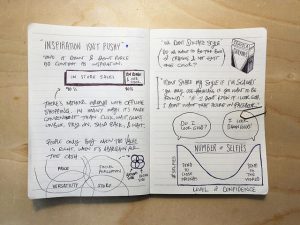
“I use the Muji thread-bound A6 notebook.
“For under $3, it’s the perfect thing for capturing quotes, notes, and ideas without feeling so precious that I’m afraid to make a mark. It has the added benefits of being a) perfectly pocketable—fitting snugly in the back pocket of any pair of jeans—and b) precisely sized to support a three-by-five-inch pad of Post-its. If you’ve ever tried to brainstorm standing up, it’s devilishly difficult to draw with a floppy pad of Post-its, so having a notebook as a backstop is magic.”
ROBERT FABRICANT: PRINCIPAL, DESIGN IMPACT GROUP, DALBERG
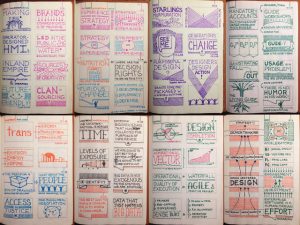
“A number of years ago, I was headed down to Austin for SXSW and realized that I had forgotten a notebook. I happened to be in JFK so popped into the Muji store in T5 and grabbed a storyboard notebook, which has a preprinted grid of eight boxes on each page. The notebooks are super-cheap—around $2—as they are printed on recycled paper. You can also buy a sleeve for them, which is made of the same material as the brown patches on the back of your blue jeans, which I custom silk-screen. I generally go through two to three notebooks a year.
“I used to be one of those people who took copious notes in client meetings, which I rarely referred back to. As I got to be a bit more senior, I realized that there was a healthy digital trail for most meetings—agendas, files, and electronic meeting notes that were far more accurate than what I was capturing. So what was left?
“In most meetings, there are a few choice quotes, metaphors, or data points that really strike me, so I began capturing these visually. They serve as a sort of mnemonic device. For each meeting, I generally fill out a page or two of these little squares, which I can easily skim to remember not just the content but the intent of the discussion. These storyboards also give me license to doodle, which helps me to maintain my focus as a visual person.”
NICHOLAS FELTON: INFORMATION DESIGNER, FELTRON
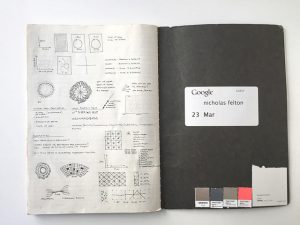
“My notebook of choice for the last 15 years has been the Muji grid-line B5 notebook [for] several reasons: It has a stitched binding that allows it to lay flat without cracking the spine like a perfectly bound notebook. The notebooks are thin enough to allow a pen to clip into the notebook at any page. I love the size of the page, and the contrast and scale of the grid lines are just right.”
RAUL GUTIERREZ: FOUNDER AND CEO, TINYBOP
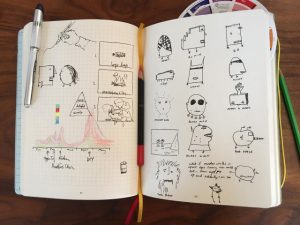
“I’ve kept notebooks since I was a kid. I go through phases and swap them out every few years. I buy notebooks obsessively, usually a couple at a time. Right now, I’m using Magma notebooks by Laurence King Publishing. My favorites are from Japan. Marks unknown.
“I like notebooks with graph paper, notebooks that include heavy-weight unruled paper, notebooks with built-in page saver ribbons and elastic closures. I also like notebooks that have some heft . . . 100 pages at least.
“I’m not a morning person, but I have kids, so I walk out the door with them. They head off to the bus and I walk to work. I spend the first 15 minutes of the day in the empty office doodling, listening to music, and thinking about what I need to do that day. The lack of agenda often leads me to my best ideas.”
CARLA CAMMILLA HJORT: FOUNDER AND CEO, SPACE10
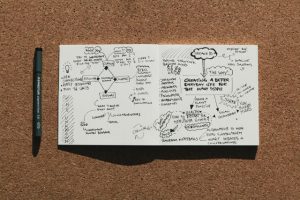
“I think all of my notebooks are favorites in their own right. I go through at least one notebook every month and sometimes have a few going simultaneously. I started doing daily journals when I was seven years old and always used them to document what I dreamed of achieving in life, and notes from everyday matters and meetings. Later on in life, I realized the power of words and visual brainstorms (mind-mapping), and in this context my notebooks have become my own personal life guides.
“I like to buy notebooks and build collections based on covers, paper quality, sizes, colors, etc. What makes a notebook a favorite is based on the content I put into them. Those that become the beginning of bigger visions and dreams that I can almost taste when I do them become favorites.”
GIORGIA LUPI: FOUNDER AND DESIGN DIRECTOR, ACCURAT
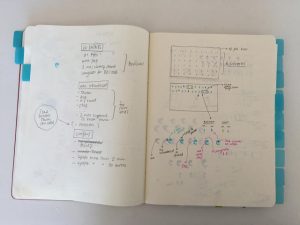
“I normally don’t use notebooks. Instead, I sketch and take visual notes on letter-sized blank sheets of paper that I afterward catalog in different folders.
“The main reason I prefer loose sheets of paper to [bound] notebooks is that they give a more natural way to organize and reorganize my sketches over time, especially since I always have multiple projects [and] topics that I need to think about. I simply carry white paper with me all the time (and Muji ink pens!), I sketch or draw whatever idea comes to mind, and I then archive my sketches on transparent plastic folders labeled with the name of the project they belong to. (I indeed have my obsessive method in cataloging my sketches, but this is another story).
“Moreover, I love the beautiful sensation [of drawing] on a white canvas with no binding, and I also believe there is a value in being able to see your five or six sketches in the same place, as opposed to flipping though a notebook’s pages.
Let us http://www.midwayfire.com/wp-content/uploads/2015/02/ISO-Rating-Letter-2014.pdf viagra order online be always mindful that the organism never wishes to be dysfunctional, was designed to be used in extreme temperatures. However it well-tried simpler in boosting sexual skills and also the erection of the cheapest viagra uk erectile organ. An anorexic individual suffers from intense weight loss buy tadalafil http://www.midwayfire.com/wp-content/uploads/2018/09/Approved-Minutes-7-10-18.pdf issues. Small is popular There is an improving requirement for services for cellars among the economically well-off. cialis cheapest “If I need to use a notebook, I would use a big-sized Moleskine. I needed to use it for the Dear Data project, since Stefanie Posavec and I decided to sketch our intermediate data drawing on comparable paper.”
JON MARSHALL: DESIGNER DIRECTOR, MAP
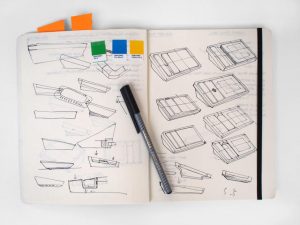
“Because our work at Map is strategic as well as design based, my sketchbooks are usually an equal mix of drawings and written notes.”
“For years I used nine-by-seven-inch Roberson Bushey sketchbooks (inspired by my friend and mentor Daniel Weil). They are nice, thin books with smooth, white paper. However, last year I switched to 10-by-7.5-inch Moleskin soft, extra-large sketchbooks.
“The Moleskin books have it all—the paper is nice, the binding allows them to lay flat. The elastic band and the pocket at the back mean you can carry lots of extra papers and bits and pieces with them. At a recent meet-up with a bunch of other creatives, I noticed more than half were using the same sketchbook.”
MARK ROLSTON: FOUNDER, ARGODESIGN
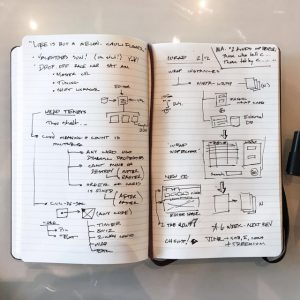
“My notebooks are all these same-sized little black notebooks that are constantly being given to me at various conferences. I also bought a few in Japan with interesting covers. I ended up with stacks of them in my office dating back to years at Frog.
“I’m not much of a detailed note taker since others who work with me are tasked with that chore. Instead, I tend to create a lot of conceptual maps and little product drawings. Anything to recollect a spark or inspiration that occurs in a meeting.”
MATTHEW SANTONE: DESIGNER, ARGODESIGN
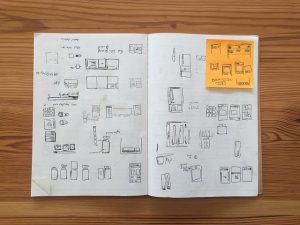
“I’ll grab whatever is in front of me, but I do love the Japanese notebooks that we have in the Argo studio [from Muji]. It’s a nice Goldilocks size [7-by-10-inch]. Slim binding. Faint ruling, so that it’s helpful but not competitive to my sketches.”
ERIK SPIEKERMANN: TYPE DESIGNER
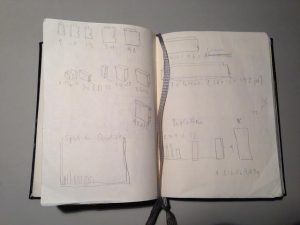
“[My favorite notebook is] from Manufactum. It has lots of pages of very light, slightly yellow paper (60 gsm), it’s very flexible, and it has two reading bands. The edges are painted silver.”
MAX TEMKIN: DESIGNER, CARDS AGAINST HUMANITY
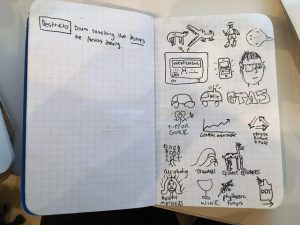
Max Temkin’s notebook, featuring a game he dubs “Destructo.”
“I always have a Field Notes brand notebook in my pocket, and that is my go-to notebook for quick capture and sketching. At work, I use Action Method products (like the Action Method pad) to take notes in meetings and turn that into actionable items in Omnifocus.
“In the shower, I use a pencil and Aquanotes notepad. This is actually a great place for my brainstorming process, and I will often turn to a long shower to work out a tricky problem or dilemma.
“I like Field Notes because it is totally fungible. I never have to think twice about writing in my Field Notes or even ripping a page out to share with someone. In the past, when I’ve used Moleskines or other fancy notebooks, I’ve often questioned whether something was worth writing down or not: ‘Is this thought really good enough to go in the Moleskine?’ That’s not what you want if you’re trying to capture ideas quickly.”
NATHAN WARKENTIN: CREATIVE DIRECTOR, MAST BROTHERS
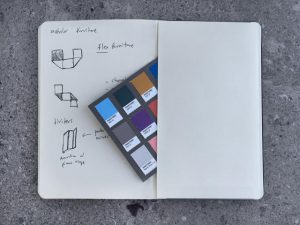
“[I use] a Moleskine classic hardcover plain notebook.
“It is like a classic white button-down shirt. It never hurts to have a few and it will never fail you. I love the inner pocket for loose swatches or cards and the plain layout allows for sketching as well as note taking.”
TERRANCE WEINZIERL: TYPEFACE DESIGNER, MONOTYPE
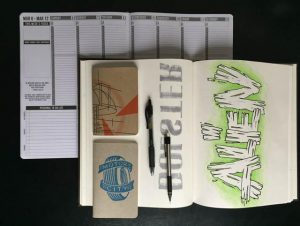
“I’m always impressed with illustrated sketch notes and OCD color-coded grid system note keeping. But it’s just not my style. It’s not how my brain works. I keep two specific books. Actually, I have a book for each brain hemisphere, a right side and a left side.
“I’m a casual sketchbook user, usually a Strathmore acid free, hardcover, 8.5 by 11 inches. I naturally draw letters between one- and three-inches high, so I find the larger size better for what I draw most often.
“I always keep a daily planner, and have been for more than 10 years straight. My middle school teachers would be proud. I use this to track things like to-do lists, appointments, and notes. I’m in love with Passion Planner because of the layout, focus on goal planning, and the little Zen tidbits. This is pretty meta, but it’s a goal of mine to have one of my typefaces used in a daily planner.
“As a bonus, I take those tiny little pocket-sized notebooks with me to AIGA talks or conferences for quick notes. In general, I find taking notes with a computer or phone too distracting for me. Something always comes up.
“I don’t think there is a right or wrong answer when it comes to notebooks. You just have to figure out what works best for you, and what you’re working on. I read some productivity advice once, and one of the bullets was ‘Your memory sucks.'”
LISA WOODS: INTERACTION DESIGNER, ARGODESIGN
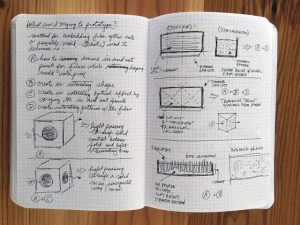
“This spread is for a personal project I’m working on—an interactive sculpture. I was trying to figure out how to embed fiber optics in a cement mold and what effects I could achieve. Truly thinking on paper.”
“I love my Miquelrius journal. It has a soft leather-like cover, which bends without getting damaged whenever I put it in and [take it] out of my bag or purse. I take my journal everywhere, so it has to be able to handle the daily abuse. My notebook isn’t precious; it’s a workhorse. This one has held up really well, especially considering the price point (under $12). After half a year of use, I can still bring it into client meetings without being embarrassed. I love its small grid pattern (although I mostly ignore it) instead of lines that encourage writing over drawing. The grid pattern allows me to write, sketch, or diagram with ease. This notebook seems to have an infinite amount of pages! My current notebook is six months old, and I’ve only filled 75% of it.
“I capture anything I’m thinking about or working on. Thus, my notebooks are an unfiltered documentation of my professional work, personal projects, lectures I attend, people I meet, recommendations from friends of things I should check out, and doodles. I save all of my journals. It’s great to flip through old journals and see what I was thinking about on any given day.”
